Social Security Administration
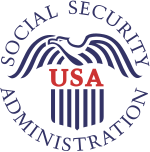 Official seal of the Social Security Administration | |
 Flag of the Social Security Administration | |
| Agency overview | |
|---|---|
| Formed | August 14, 1935 |
| Jurisdiction | Federal government of the United States |
| Headquarters | Woodlawn, Maryland, U.S. |
| Employees | 60,000 |
| Annual budget | $1.06 trillion (FY 2018)[1] |
| Agency executive |
|
| Website | www |
The United States Social Security Administration (SSA)[2] is an independent agency of the U.S. federal government that administers Social Security, a social insurance program consisting of retirement, disability, and survivor benefits. To qualify for most of these benefits, most workers pay Social Security taxes on their earnings; the claimant's benefits are based on the wage earner's contributions. Otherwise benefits such as Supplemental Security Income (SSI) are given based on need.
The Social Security Administration was established by a non-positive law codified at 42 U.S.C. § 901 (49 Stat. 635). It was created in 1935 as the "Social Security Board", then assumed its present name in 1946. Its former leader, Commissioner Andrew Saul, served from June 2019 until July 2021, succeeding Acting Commissioner Nancy Berryhill. On July 9, 2021 the Biden administration announced Saul would be fired, and replaced on an Acting basis by Deputy Commissioner (Office of Retirement and Disability Policy) Kilolo Kijakazi.[3]
SSA is headquartered in Woodlawn, Maryland, just to the west of Baltimore, at what is known as Central Office. The agency includes 10 regional offices, 8 processing centers, approximately 1300 field offices, and 37 Teleservice Centers. As of 2018, about 60,000 people were employed by SSA.[4] Headquarters non-supervisory employees of SSA are represented by American Federation of Government Employees Local 1923. Social Security is the largest social welfare program in the United States. For 2014, the net cost of Social Security was $906.4 billion, an amount corresponding to 21% of US Federal Government expenditures.[5] By 2020, it had increased to $1.10 trillion.[6]
History[]

The Social Security Act created a Social Security Board (SSB),[7] to oversee the administration of the new program. It was created as part of President Franklin D. Roosevelt's New Deal with the signing of the Social Security Act of 1935 on August 14, 1935.[8] The Board consisted of three presidentially appointed executives, and started with no budget, no staff, and no furniture. It obtained a temporary budget from the Federal Emergency Relief Administration headed by Harry Hopkins.[7] The first counsel for the new agency was Thomas Elliott, one of Felix Frankfurter's "happy hot dogs".[9][10][11]
The first Social Security office opened in Austin, Texas, on October 14, 1936 [12] Social Security taxes were first collected in January 1937, along with the first one-time, lump-sum payments.[8] The first person to receive monthly retirement benefits was Ida May Fuller of Brattleboro, Vermont. Her first check, dated January 31, 1940 was in the amount of US$22.54.[13]
In 1939, the Social Security Board merged into a cabinet-level Federal Security Agency, which included the SSB, the U.S. Public Health Service, the Civilian Conservation Corps, and other agencies.[14] In January 1940, the first regular ongoing monthly benefits began.[8] In 1946, the SSB was renamed the Social Security Administration under President Harry S. Truman's Reorganization Plan.
In 1953, the Federal Security Agency was abolished and SSA was placed under the Department of Health, Education, and Welfare, which became the Department of Health and Human Services in 1980. In 1994, President Bill Clinton amended non-positive law 42 U.S.C. § 901 and returned SSA to the status of an independent agency in the executive branch of government. In 1972, Cost of Living Adjustments (COLAs) were introduced into SSA programs to deal with the effects of inflation on fixed incomes.[15]
Leaders[]
Social Security Commissioners [16]
| Commissioners | Years Served |
|---|---|
| Arthur J. Altmeyer | July 16, 1946 – April 10, 1953 |
| (Acting) | April 11, 1953 – November 23, 1953 |
| John W. Tramburg | November 24, 1953 – July 31, 1954 |
| Charles I. Schottland | August 23, 1954 – December 31, 1958 |
| February 4, 1959 – April 3, 1962 | |
| Robert M. Ball | April 17, 1962 – March 17, 1973 |
| Arthur E. Hess (Acting) | March 18, 1973 – October 24, 1973 |
| James B. Cardwell | October 25, 1973 – December 12, 1977 |
| Don I. Wortman (Acting) | December 13, 1977 – October 4, 1978 |
| Stanford G. Ross | October 5, 1978 – December 31, 1979 |
| (Acting) | January 1, 1980 – January 2, 1980 |
| William J. Driver | January 3, 1980 – January 19, 1981 |
| (Acting) | January 20, 1981 – May 5, 1981 |
| John A. Svahn | May 6, 1981 – September 12, 1983 |
| (Acting) | September 14, 1983 – June 25, 1986 |
| Dorcas R. Hardy | June 26, 1986 – July 31, 1989 |
| Gwendolyn S. King | August 1, 1989 – September 30, 1992 |
| (Acting) | October 1, 1992 – July 18, 1993 |
| (Acting) | July 19, 1993 – October 7, 1993 |
| Shirley S. Chater | October 8, 1993 – February 28, 1997 |
| March 1, 1997 – September 28, 1997 | |
| Kenneth S. Apfel | September 29, 1997 – January 20, 2001 |
| William Halter (Acting) | January 21, 2001 – March 28, 2001 |
| (Acting) | March 29, 2001 – November 9, 2001 |
| Jo Anne B. Barnhart | November 9, 2001 – January 19, 2007 |
| (Acting) | January 20, 2007 – February 11, 2007 |
| Michael J. Astrue | February 12, 2007 – February 13, 2013 |
| Carolyn W. Colvin (Acting) | February 14, 2013 – January 20, 2017 |
| Nancy A. Berryhill (Acting) | January 21, 2017 – June 17, 2019 |
| Andrew M. Saul | June 17, 2019 – July 9, 2021 |
| Kilolo Kijakazi (Acting) | July 9, 2021 – present |
Headquarters[]

SSA was one of the first federal agencies to have its national headquarters outside of Washington, D.C., or its adjacent suburbs. It was located in Baltimore initially due to the need for a building that was capable of holding the unprecedented amount of paper records that would be needed. Nothing suitable was available in Washington in 1936, so the Social Security Board selected the Candler Building on Baltimore's harbor as a temporary location. Soon after locating there, construction began on a permanent building for SSA in Washington that would meet their requirements for record storage capacity. However, by the time the new building was completed, World War II had started, and the building was commandeered by the War Department. By the time the war ended, it was judged too disruptive to relocate the agency to Washington. The Agency remained in the Candler Building until 1960, when it relocated to its newly built headquarters in Woodlawn.[17]
The road on which the headquarters is located, built especially for SSA, is named Security Boulevard (Maryland Route 122) and has since become one of the major arteries connecting Baltimore with its western suburbs. Security Boulevard is also the name of SSA's exit from the nearby Baltimore Beltway (Interstate 695). A nearby shopping center has been named Security Square Mall, and Woodlawn is often referred to informally as "Security." Interstate 70, which runs for thousands of miles from Utah to Maryland, terminates in a park and ride lot that adjoins the SSA campus.
Due to space constraints and ongoing renovations, many headquarters employees work in leased space throughout the Woodlawn area. Other SSA components are located elsewhere. For example, the headquarters (also known as Central Office) of SSA's Office of Disability Adjudication and Review is located in Falls Church, Virginia.
Field Offices[]
SSA has a network of more than 1,200 community-based field offices. In fiscal year 2019, 43 million individuals visited these field offices to apply for benefits, get an original or replacement Social Security card, or receive other services.[18]
Due to the COVID-19 pandemic, SSA temporarily closed its field offices to the public in March 2020.[19] Members of the public can still apply for benefits by calling SSA's national toll-free number (1-800-772-1213) or calling their local field office.[20] In addition, retirement and disability benefits can be applied for online.[21] For other benefits, such as survivor benefits and Supplemental Security Income benefits, members of the public may have to call SSA to apply.
In many cases, individuals seeking a replacement Social Security card can apply for one online.[22]
Program Service Centers[]
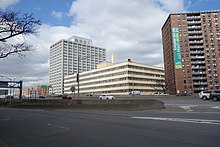
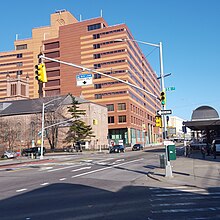
Much of the actual processing of initial benefits and subsequent adjustments to benefits is done in six large Program Service Centers located around the country.[23]
The two main positions in Program Service Centers have long been Claims Authorizers and Benefits Authorizers.[24][25] Claims Authorizers, now sometimes called claims specialists, establish initial benefits for program recipients.[26] Benefits Authorizers process complicated changes of entitlements to existing beneficiaries, including life events, overpayments, underpayments, and so forth.[26][25] The claims position is the higher-ranking of the two and initially required a college degree whereas the post-entitlement position did not.[25] For decades, post-entitlement actions have been processed through a system known as Manual Adjustment, Credit and Award Processes (MADCAP).[27]
The six service centers are:[23]
- Northeastern Program Service Center, Jamaica, Queens, New York (as of late 1980s; previously in Rego Park, Queens and College Point, Queens)[28]
- Mid-Atlantic Program Service Center, Philadelphia, Pennsylvania
- Southeastern Program Service Center, Birmingham, Alabama
- Great Lakes Program Service Center, Chicago, Illinois
- Mid-America Program Service Center, Kansas City, Missouri
- Western Program Service Center, Richmond, California (as of mid 1970s; previously in San Francisco)[29]
They have been located in these six cities going back to at least the early 1950s.[30] The origins of the payment centers date back to 1942, when they were known as Area Offices.[31] The first one was established in Philadelphia, with ones in New York, Chicago, San Francisco, and New Orleans, Louisiana soon following.[24]
In addition, there are specialized processing centers for the Office of Earnings and International Operations and the Office of Disability Operations, both located in Baltimore.[23]


Before the mid-1970s, the Program Service Centers were called Payment Centers.[32] By the late 1960s, the Payment Centers had acquired a reputation as sources of poor bureaucratic performance that people did not want to work in, and a reorganization under a modules system was undertaken during the 1970s in an effort to improve matters.[24] Each module would be assigned a certain block of social security numbers and it would process all aspects of a claim, from initial entitlement through various changes, notifications to beneficiaries, and so forth.[25] Decades later, the modules system was still seen as one of the great improvements in SSA processing.[25]
The centers have each employed around two thousand people or more, giving them a major local economic impact, and even relocations within the same metropolitan area have created political conflict. When in the early 1970s, SSA and the General Services Administration said it intended to move payment center operations out of San Francisco and across the East Bay to Richmond, the move was opposed by San Francisco-representing Congressman Phillip Burton.[33] Burton's efforts were in vain, however, as construction in a redevelopment area in Richmond commenced and the move was made around 1975.[29]
Similarly, in the late 1970s, SSA, the General Services Administration, and the Carter administration devised a plan to move the program service center from its main location, in two leased buildings on Horace Harding Expressway in Lefrak City in Rego Park, to a new federal building planned for a revitalization zone in the center of the Jamaica area of Queens.[34][35] The move was championed by Congressman Joseph P. Addabbo, who represented Jamaica and whose district would gain the over 2,000 federal workers involved, but was opposed by Congressman Benjamin Rosenthal, whose district would lose them.[36] According to Rosenthal, the potential negative impact of the move affected the Elmhurst and Corona neighborhoods most strongly.[37] The move was also supported by Representative Geraldine Ferraro, another powerful Queens figure, who sat on the House Public Works Committee.[34] The dispute was aired in Congressional hearings and embroiled Senator Daniel Patrick Moynihan and developer Richard Lefrak, supporting and opposing the move respectively, as well.[38] In the event, the move went forward and the new, 11-story building in Jamaica – by then named the Joseph P. Addabbo Federal Building, as the congressman had died in the interim – opened in 1988.[39]
Coverage[]
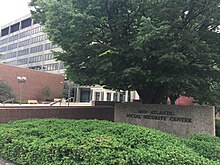
Initially, only 56 percent of the jobs in the United States were covered by Social Security. Today, the system is nearly universal, with 94 percent of individuals in paid employment in the United States working in covered employment.[40]
State and local government workers are not required to participate in the Social Security program if they participate in a public retirement system through their employers. However, state and local governments, through agreements known as Section 218 agreements,[41] may elect to participate in the program. Of the 23.2 million state and local workers in the United States, about 6.6 million are not covered by Social Security. Other workers not covered by Social Security include federal employees hired before 1984, railroad workers, some family employees, some students, and some members of the clergy.[42]
If a job is not covered by Social Security, workers and employers do not pay Social Security payroll taxes. Social Security retirement and disability benefits are not payable unless individuals have sufficient work in Social Security covered employment. Individuals who work part of their careers in covered employment and part of their careers in non-covered employment and who receive pensions from non-covered employment may have their Social Security benefits reduced through the Windfall Elimination Provision (WEP)[43] or the Government Pension Offset (GPO).[44]
Railroad workers were covered by the Railroad Retirement Board before Social Security was founded. Today, they still are, though a portion of each railroad pension is designated as "equivalent" to Social Security. Railroad workers also participate in Medicare. All state and local government employees hired since 1986, or whom are covered by Section 218 Agreements, participate in Medicare even if not covered for purposes of Social Security benefits.[45]
Old age, survivors and disability[]
SSA administers the retirement, survivors, and disabled social insurance programs, which can provide monthly benefits to aged or disabled workers, their spouses and children, and to the survivors of insured workers. In 2010, more than 54 million Americans received approximately $712 billion in Social Security benefits. The programs are primarily financed by taxes which employers, employees, and the self-insured pay annually. These revenues are placed into a special trust fund. These programs are collectively known as Retirement, Survivors, Disability Insurance (RSDI).
SSA administers its disability program partly through its Office of Disability Adjudication and Review (ODAR), which has regional offices and hearing offices across the United States. ODAR publishes a manual, called HALLEX, which contains instructions for its employees regarding how to implement its guiding principles and procedures.
The RSDI program is the primary benefits program administered by the U.S. federal government, and for some beneficiaries is the vital source of income. Increasing access to this benefit program for low-income or homeless individuals is one of SSA's goals. SSA is a member of the United States Interagency Council on Homelessness[46] and works with other municipal, county, state, local and federal partners to increase access and approval for SSI/SSDI benefits who are eligible.
Supplemental Security Income (SSI)[]

SSA also administers the Supplemental Security Income (SSI) program, which is needs-based, for the aged, blind, or disabled. Prior to the 1972 Amendments to the Social Security Act, low-income aged, blind, or disabled persons received benefits from state-run programs called Old-Age Assistance, Aid to the Blind, and Aid to the Permanently and Totally Disabled. These programs received federal funding, but varied in terms of eligibility requirements and benefit payments. The 1972 Amendments replaced these programs with the SSI program. SSA was assigned responsibility for the SSI program and began operations in 1974.[47] Federal benefit payments up to $794 for an SSI individual and $1,191 for an SSI couple are available from the program. SSI benefits are paid out of the general revenue of the United States of America. Some states supplement the federal amount.
Because SSI is needs-based, eligibility is restricted to persons with limited income and resources. In addition, eligibility is generally restricted to U.S. citizens, nationals, and some other groups (such as some refugees) who reside in one of the 50 U.S. states, the District of Columbia, or the Northern Mariana Islands.[48] U.S. citizens and nationals who reside in American Samoa, Guam, Puerto Rico, and the U.S. Virgin Islands are not eligible for SSI.[49] In 2019, 8 million individuals received SSI, including 1.1 million disabled children, 4.6 million disabled adults, and 2.3 million persons 65 or older. [50]
In some cases, individuals may be eligible for Social Security (RSDI) benefits and SSI benefits. For example, a disabled individual who worked in Social Security-covered employment and who has limited income and resources may receive a Social Security disability benefit (due to employment prior to disability) and a partial SSI benefit (due to limited income and resources). SSA refers to these beneficiaries as "concurrent" beneficiaries.
Medicare[]
The administration of the Medicare program is a responsibility of the Centers for Medicare and Medicaid Services, but SSA offices are used for determining initial eligibility, some processing of premium payments, and for limited public contact information. They also administer a financial needs-based program called Extra Help, which helps beneficiaries pay the premiums, deductibles, and coinsurance associated with prescription drug coverage under Part D of Medicare. Benefits under this program are estimated to be worth about $5,000 per year. Individuals may apply online for the Extra Help program or by calling SSA.[51]
Operations[]
To ensure consistent and efficient treatment of Social Security beneficiaries across its vast bureaucracy, SSA has compiled a giant book known as the Program Operations Manual System (POMS) which governs practically all aspects of SSA's internal operations. POMS describes, in excruciating detail, a huge variety of situations regularly encountered by SSA personnel, and the exact policies and procedures that apply to each situation.[52]
Automation[]


While the establishment of Social Security predated the invention of the modern digital computer, punched card data processing was a mature technology, and the Social Security system made extensive use of automated unit record equipment from the program's inception. This allowed the Social Security Administration to achieve a high level of efficiency. SSA expenses have always been a small fraction of benefits paid. As a percentage of assets, the administration costs are 0.39%.[53]
Adjudication[]
SSA operates its own administrative adjudication system, which has original jurisdiction when claims are denied in part or in full. SSA decisions are issued by Administrative Law Judges and Senior Attorney Adjudicators (supported by about 6,000 staff employees) at locations throughout the United States of the U.S. Office of Hearing Operations (OHO prounounced "oh,oh") formerly Office of Disability Adjudication and Review (ODAR), who hear and decide challenges to SSA decisions. Dissatisfied claimants can appeal to ODAR's Appeals Council, and if still dissatisfied can appeal to a U.S. District Court.
Over the years, OHO aka ODAR has developed its own procedural system, which is documented in the Hearings and Appeals Litigation Law Manual (HALLEX). ODAR was formerly known as the Office of Hearings and Appeals (OHA) and, prior to the 1970s, the Bureau of Hearings and Appeals. The name was changed to ODAR in 2007 to reflect the fact that about 75% of the agency's docket consists of disability cases. OHO aka ODAR also adjudicates disputes relating to retirement claims and has jurisdiction when the paternity of a claimant or the validity of a marriage is at issue when a claim is filed for benefits under the earnings record of a spouse or parent. The agency also adjudicates a limited number of Medicare claim issues, which is a residual legacy from when SSA was part of the U.S. Department of Health and Human Services.
Criticism and controversy[]
Bloomberg reported that SSA made a $32.3 billion mistake when reporting 2009 U.S. wage statistics. The error when corrected, further reduces the average 2009 U.S. wage to $39,055.[54] In 2009 the average U.S. wage was reported as $39,269.[55]
Baby name popularity report[]
Each year, just before Mother's Day, SSA releases a list of the names most commonly given to newborn babies in the United States in the previous year, based on applications for Social Security cards. The report includes the 1,000 most common names for both genders. The Popular Baby Names page on the SSA website provides the complete list and allows searches for past years and particular names.[56] For privacy reasons, SSA does not publish data for names with fewer than five occurrences in any given year. [57]
See also[]
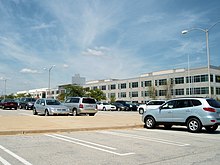
- Social programs in the United States
- Public finance
- Social Security Death Index
- Social Security Disability Insurance
- Michael J. Astrue, Commissioner of the Social Security Administration from 2007 to 2013
- NOSSCR, National Organization of Social Security Claimants' Representatives
- Richardson v. Perales
- Ticket to Work, SSA's Ticket to Work Program
- Title 20 of the Code of Federal Regulations
- Data.gov
- USAFacts
- SSA impersonation scam
References[]
- ^ Social Security and Medicare Boards of Trustees. "A Summary Of The 2017 Annual Reports". Office of the Chief Actuary, Social Security Administration.
- ^ (SSA Pub. No 25-1556 p. 7)
- ^ Zeleny, Jeff. "Biden fires top official at Social Security Administration after he refuses to resign". CNN.com. CNN. Retrieved 9 July 2021.
- ^ SSA, How We're Organized, accessed 23 July 2018
- ^ "Financial Report Fiscal Year 2014 of the United States Government" (PDF). Retrieved 2015-02-25.
- ^ "Government Spending Trends Over Time | U.S. Treasury Data Lab". datalab.usaspending.gov. Retrieved 2021-05-07.
- ^ Jump up to: a b Social Security Administration. "Brief Graphic Organizational History". U.S. Government. Retrieved 2007-05-24.
- ^ Jump up to: a b c (SSA Pub. No 25-1556 p. 15)
- ^ "Trenton Facts". The Courier-News of Bridgewater, NJ. 4 October 1935. p. 21. Retrieved 18 August 2017.
- ^ Henning, Arthur Sears (4 October 1935). "New 'Hot Boss' Fears High Courts: Laws So 'Learned' They Defeat Purpose". Chicago Tribune. p. 21. Retrieved 18 August 2017.
- ^ "Inferiority Complex". Review of Reviews. 1936: 29. Retrieved 18 August 2017. Cite journal requires
|journal=(help) - ^ "Social Security History". www.ssa.gov.
- ^ Social Security Administration. "The First Social Security Beneficiary". U.S. Government. Retrieved 2007-05-24.
- ^ Social Security Administration. "Special Collections Chronology: 1930". U.S. Government. Retrieved 2007-05-24.
- ^ "Cost-of-Living Adjustment (COLA) Information | Social Security Administration". www.ssa.gov. Retrieved 2018-08-06.
- ^ "Social Security History - Social Security Commissioners". www.ssa.gov.
- ^ "The Candler Building". www.ssa.gov.
- ^ "Testimony by Grace Kim, Deputy Commissioner for Operations, Social Security Administration, before the Senate Committee on Finance, on Service Delivery". www.ssa.gov.
- ^ "Office Closings and Emergencies". www.ssa.gov.
- ^ "Social Security Office Locator". www.ssa.gov.
- ^ "Online Services". www.ssa.gov.
- ^ "Request a Replacement Social Security Number (SSN) Card Online". www.ssa.gov.
- ^ Jump up to: a b c "GN 01050.051 Who reviews and services claims". Program Operations Manual System (POMS). Social Security Administration. May 25, 2018. Retrieved March 17, 2019.
- ^ Jump up to: a b c Garcia, O. R. (January 18, 1974). "Historical Interview with Milton Freedman". Social Security History: Oral Histories. Social Security Administration.
- ^ Jump up to: a b c d e "Oral Histories: 'Pat' Caligiuri". Social Security History: Oral Histories. Social Security Administration. April 8, 2010.
- ^ Jump up to: a b "Positions Available at SSA". Social Security Administration. Retrieved March 17, 2019.
- ^ "Payments Resulting from Disability Insurance Actions Processed Via Manual Adjustment, Credit and Award Processes". Social Security Administration. June 28, 2013. Retrieved June 29, 2019.
- ^ Queens, Proposed Federal Building: Environmental Impact Statement. Social Security Administration. 1981.
- ^ Jump up to: a b "Richmond To Dig S.F. Loss". The San Francisco Examiner. July 31, 1973. p. 3 – via Newspapers.com.
- ^ Analysis of the Social Security System: Hearings Before a Subcommittee of the Committee on Ways and Means, House of Representatives, 83rd Congress, First Session, Parts 1-8. U.S. Government Printing Office. 1953. p. 570.
- ^ "Organizational History". Social Security History. Social Security Administration. Retrieved March 17, 2019.
- ^ Supplemental Appropriation Bill for 1962: Hearings, Committee on Appropriations, United States Senate, 87th Congress, First Session, H.R. 9169. U.S. Government Printing Office. 1961. p. 301.
- ^ "S.F. to Lose Big Payroll?". The San Francisco Examiner. December 7, 1972. p. 11 – via Newspapers.com.
- ^ Jump up to: a b Molotsky, Irvin (November 16, 1979). "Federal Building in Queens Urged to Aid Economy". The New York Times. p. B3.
- ^ Dallas, Gus (April 20, 1980). "A biz district is finding the road back". Daily News. New York. p. 3B XQL – via Newspapers.com.
- ^ Rainie, Harrison (December 14, 1979). "Site for fed office stirs row". Daily News. New York. p. XQ1 – via Newspapers.com.
- ^ Murray, Alice (February 4, 1980). "SS move called disaster". Daily News. New York. p. 3XQ – via Newspapers.com.
- ^ Hardy, David (April 20, 1980). "Battle's building up on fed office". Daily News. New York. pp. 1B, 3B XQL – via Newspapers.com.
- ^ Davila, Albert (November 11, 1988). "Jamaica on the march". Daily News. New York. p. XQ1 – via Newspapers.com.
- ^ "Social Security: Who Is Covered Under the Program?". Congressional Research Service.
- ^ "Social Security Coverage for State and Local Government Employees". Social Security Administration.
- ^ "Social Security: Who Is Covered Under the Program?". Congressional Research Service.
- ^ "Program Explainer: Windfall Elimination Provision". Social Security Administration.
- ^ "Program Explainer: Government Pension Offset" (PDF). Social Security Administration.
- ^ "Social Security Publications". Socialsecurity.gov. Retrieved 2012-05-09.
- ^ "Member Agency | United States Interagency Council on Homelessness (USICH)". Usich.gov. Archived from the original on 2012-04-24. Retrieved 2012-05-09.
- ^ "History of the SSI program". www.ssa.gov.
- ^ "Understanding Supplemental Security Income SSI Eligibility Requirements -- 2021 Edition". www.ssa.gov.
- ^ "U.S. House of Representatives Committee on Ways and Means Greenbook".
- ^ "SSI Recipients by State and County, 2019". www.ssa.gov.
- ^ "Extra Help with Medicare Prescription Drug Plan Costs". www.ssa.gov.
- ^ "SSA's Policy Information Site - POMS - About POMS". secure.ssa.gov.
- ^ Robert Genetski. "Administration Costs and the Relative Efficiency of Public and Private Social Security Systems". CATO Institute. Retrieved 2010-09-27.
- ^ Donmoyer, Ryan J. (2010-11-02). "'Invalid' Forms by Supposed Billionaires Skew U.S. Wage Figures". Bloomberg. Archived from the original on 2010-11-04. Retrieved 2012-05-09.
- ^ "Reversing Trends" (PDF). Archived from the original (PDF) on 2010-11-30. Retrieved 2012-05-09.
- ^ Social Security Administration. "Popular Baby Names". U.S. Government. Retrieved 2007-05-24.
- ^ Social Security Administration. "Background information for popular names". U.S. Government. Retrieved 2021-06-04.
All Social Security Offices in USA
Further reading[]
- Social Security Disability Advocate's Handbook, by David Traver, James Publishing, 2006, ISBN 1-58012-033-4
- Social Security Handbook, Germania Publishing, 2006.
External links[]
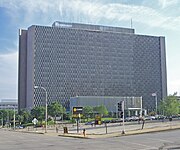
- Official website

- Program Operations Manual System (POMS) – public online version of the procedure by which SSA employees process decisions about benefits
- Historical Background And Development Of Social Security by Social Security Administration
- Social Security Administration on USAspending.gov
- Social Security Administration in the Federal Register
- Works by Social Security Administration at Project Gutenberg
- Works by or about Social Security Administration at Internet Archive
- Papers of Charles I. Schottland, former Commissioner of Social Security, Dwight D. Eisenhower Presidential Library
- Social Security Administration Office Locations
- SSA Pub. No 25-1556. Teleservice Representative Basic Training Curriculum Introduction Unit 1 Lessons 01-08 Student. pp. 7–15. Social Security Administration. April 2006.
- Baltimore County, Maryland landmarks
- Government agencies established in 1935
- Independent agencies of the United States government
- New Deal agencies
- Social security in the United States